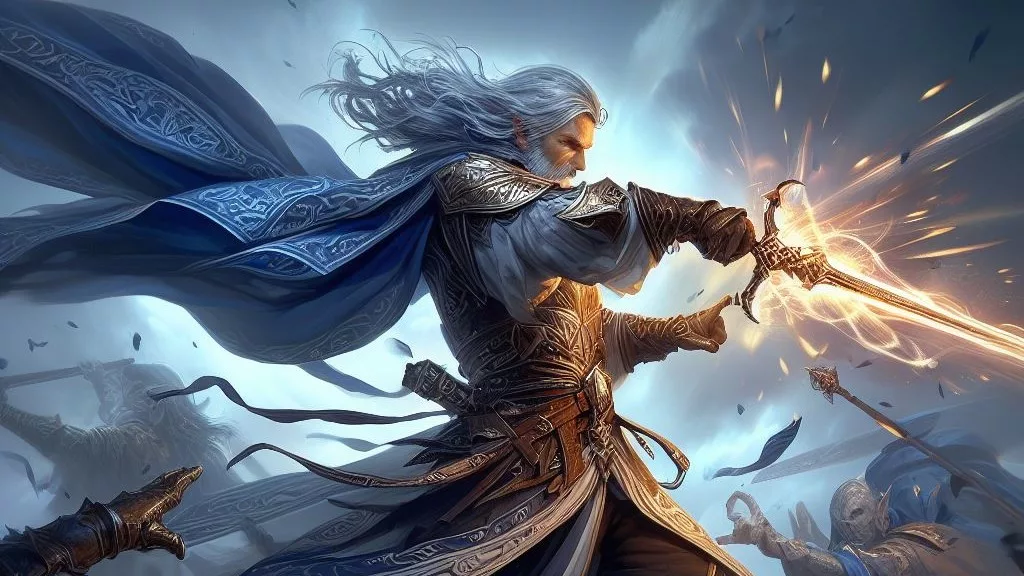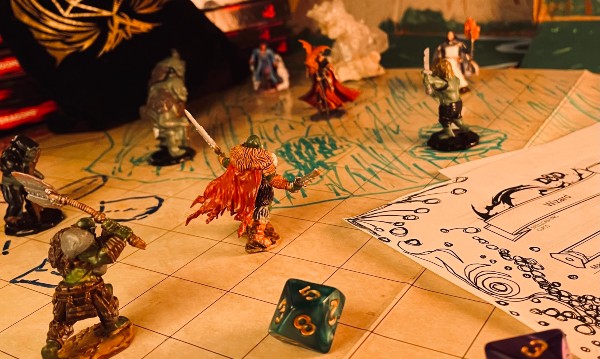You create a momentary circle of spectral blades that sweep around you. All other creatures within 5 feet of you must succeed on a Dexterity saving throw or take 1d6 force damage.
This spell’s damage increases by 1d6 when you reach 5th level (2d6), 11th level (3d6), and 17th level (4d6).
Casting Time: 1 action
Range: Self (5-foot radius)
Components: V
Duration: Instantaneous
School: Conjuration cantrip
Who can cast Sword Burst? Sorcerers, Warlocks, Wizards, and Artificers have Sword Burst on their class spell lists.
Tasha’s Cauldron of Everything, pg. 115
Sword Burst 5e
DnD 5e’s Sword Burst was originally a cantrip from the Sword Coast Adventurer’s Guide, along with Booming Blade, Green-Flame Blade, and Lightning Lure. Both then and when the spells were later made official in Tasha’s Cauldron of Everything, players seemed keener on the Blade spell combos than Sword Burst.
That said, this area of effect cantrip has its place in certain character builds, even if it’s not the first choice for most full-casters. I’ll cover Sword Burst’s rules and applications, as well as identify subclasses that can make the most out of the spell.
How Does Sword Burst Work in 5e?
Sword Burst forces all creatures (allies and enemies) within 5 feet of the caster to make a Dexterity saving throw. If a creature fails, it takes 1d6 (3.5 average) force damage. Nothing happens if it succeeds.
Sword Burst’s damage automatically increases with character level, dealing an additional 1d6 force damage at levels 5, 11, and 17.
How to Use Sword Burst in 5e
Here are a few ways to use Sword Burst in DnD 5e:
-
Go for a gish build. Eldritch Knight Fighters, Hexblade Warlocks, and Bladesinging Wizards come to mind. For Sword Burst to be truly effective, you have to be focused on more than just being a melee caster — you have to be somewhat of a tank.
Sword Burst’s damage goes up the more surrounded by enemies you are, but so does the potential incoming damage. Take advantage of the Verbal-only component aspect of Sword Burst and throw on a shield to boost your AC, wear full plate, and make other tank-minded build decisions.
In particular, EK’s War Magic feature and Bladesinging Wizard’s Extra Attack both allow for a cantrip in place of a regular attack, making Sword Burst builds much more attractive. Sword Burst becomes the AoE go-to, while spells like Booming Blade and Green-Flame Blade become the cantrips of choice for smaller groups of enemies.
-
Use it against big groups of weak enemies. Sword Burst’s big downside is that you have to put yourself in harm’s way in order to maximize its damage. But if you can eliminate one or two of the baddies by casting Sword Burst, your defensive prospects will get a whole lot brighter.
This is especially potent against enemies with Pack Tactics, like kobolds, who are incentivized to group up — making them perfect fodder for your spectral force blades.
-
Think about your allies. Last but certainly not least, consider the positioning of your allies before casting Sword Burst. Communicate your intentions before they make their move, so you can ensure that they’re if a safe place.
On the other hand, your allies should be considering you. Ask for defensive buffs like Shield of Faith before going in. After casting, have your allies focus fire whatever enemies took damage from Sword Burst to use your party’s resources most efficiently.
What Are the Rules for Sword Burst in 5e?
The rules for Sword Burst in DnD 5e are as follows:
-
Sword Burst hits allies. The spell’s description clearly reads “All other creatures” — this includes all allies, except the caster themself.
-
Sword Burst only has a Verbal component. Meaning you don’t need the War Caster feat to cast this spell while you hold a shield and weapon. This is an advantage over spells with a somatic and/or material component, which require at least one free hand to cast without the War Caster feat.
-
You only roll Sword Burst’s damage once. Like all area of effect spells (and Magic Missile) in DnD 5e, you roll one die (or set of dice) to determine how much damage the spell will deal to each enemy hit (PHB 196; Damage Rolls).
-
Sword Burst does not work with Sorcerer’s Distant Spell metamagic (PHB 102). Because this feature requires “a spell that has a range of 5 feet or greater.” Sword Burst’s range is Self (5-foot radius), which means it cannot interact with Distant Spell.
Distant Spell works only on a spell that has either a range of 5 feet or more or a range of touch. If a spell's Range entry says "Self," the spell doesn't qualify. #DnD https://t.co/OuGI7zBgXq
— Jeremy Crawford (@JeremyECrawford) June 11, 2018
Who Can I Target With Sword Burst 5e?
You target the 8 squares around you with Sword Burst, as well as the space above and below you.
Is Sword Burst 5e a Good Spell?
Yes, Sword Burst is a good spell — but not for full casters. It’s a much more effective option for character builds that focus on combining magic and martial tactics in combat.
In particular, Sword Burst is best for characters that take on the role of main tank for their party, as they’re most likely to be surrounded by enemies, which is exactly when Sword Burst does its greatest damage.
Additionally, Sword Burst’s force damage is a small, but welcome advantage for the spell. Force damage is the least resisted damage type in DnD 5e, as only two creatures in the game’s main sourcebooks are immune to it, and only five are resistant.
Sword Burst 5e Compared to Thunderclap
Sword Burst is objectively better than Thunderclap, unless a character has features/feats that directly benefit thunder damage or from casting thunder spells.
Thunderclap deals thunder damage (not a common immunity/resistance either, but still more common than force damage) and forces a Constitution saving throw instead of Dexterity. Monster’s Constitution modifiers tend to be higher than their Dexterity modifiers, so Sword Burst will land more reliably against more enemies.
Finally, Thunderclap causes a loud noise that’s audible up to 100 feet away, making it unusable during stealth missions.
Also in the mix: Word of Radiance functions the same way as both Sword Burst and Thunderclap, but benefits from only targeting enemies.
DnD 5e Sword Burst FAQ
Sword Burst DnD 5e FAQ:
-
Does Sword Burst hurt allies? Yes, Sword Burst affects all creatures within its area, including allies.
-
Does Sword Burst work with Distant Spell metamagic? No, Sword Burst has a range of Self (5-foot radius) instead of 5 feet, and, therefore, cannot be affected by Distant Spell metamagic, which specifically modifies spells with a range of touch or ranged spells.
Simple Sword Burst 5e Spell Text
Sword Burst: (Conjuration cantrip, Self (5-foot radius), V) All other creatures within 5 feet of you must succeed on a Dexterity saving throw or take 1d6 force damage. | +1d6 at levels 5, 11, and 17.
How Other Conjuration Spells Work in DnD 5e
Create Bonfire D&D
Infestation D&D
Mage Hand D&D
Entangle D&D
Find Familiar D&D
Ice Knife D&D
Cloud of Daggers D&D
Flaming Sphere D&D
Healing Spirit D&D
Misty Step D&D
Web D&D
Call Lightning D&D
Sleet Storm D&D
Spirit Guardians D&D


![Fly 5e [DnD Spell Guide, Tips, Rules, Uses] misty-step-5e](https://www.dndlounge.com/wp-content/uploads/2022/03/misty-step-5e-300x161.jpg)
![Flaming Sphere 5e [DnD Spell Guide: Uses, Rules, Tips] find-familiar-5e](https://www.dndlounge.com/wp-content/uploads/2022/03/find-familiar-5e-300x159.jpg)
![Barkskin 5e [DnD Spell Guide: Uses, Rules, Tips] dungeons-and-dragons-party-vs-troll-minis](https://www.dndlounge.com/wp-content/uploads/2022/03/dungeons-and-dragons-party-vs-troll-minis-300x200.jpg)
![Spike Growth 5e [DnD Spell Guide: Uses, Rules, Tips] entangle-5e-druid](https://www.dndlounge.com/wp-content/uploads/2022/03/entangle-5e-druid-300x174.jpg)